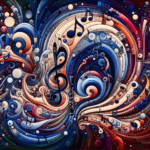Introduction to the D Augmented Scale
The D Augmented Scale has left an indelible mark on clarinet music history, offering a captivating subject for exploration. Many musicians might not fully grasp its impact, but once discovered, it reveals a wealth of creative possibilities. This scale combines whole and half steps, producing a distinctive sound that mesmerizes listeners. Composed of the notes D, E, F#, G#, A#, and B, it creates a bright, enigmatic sound capable of evoking various emotions based on its application. When played, its resonance is palpable, contributing to its unique appeal.

Clarinet Fingering Charts are always FREE at MartinFreres.net!
Historical Significance in the Romantic Period
The D Augmented Scale gained prominence during the late Romantic period, with renowned composers like Claude Debussy and Maurice Ravel delving into its potential. Debussy incorporated it in pieces such as Voiles, infusing them with a dreamlike quality. Meanwhile, Ravel integrated it into his jazz-influenced compositions, showcasing the scale's adaptability. It's remarkable how these two legendary composers utilized the same scale yet created vastly different musical landscapes!
The Jazz Era and Beyond
As we enter the 20th century, the D Augmented Scale experiences a resurgence. Jazz musicians embraced it as a valuable improvisational tool, using it to craft intricate melodies that diverged from traditional scale patterns. The beauty of improvisation lies in each musician's unique interpretation of the scale. Consider how the same notes can evoke a range of emotions depending on the player's approach – this is the essence of musical expression!
| Era | Musical Style | Notable Uses of D Augmented Scale |
|---|---|---|
| Late Romantic | Impressionism | Debussy's Voiles, Ravel's compositions |
| 20th Century | Jazz | Improvisation tool, Benny Goodman's solos |
| Contemporary | Classical, Jazz fusion | Concertos, sonatas, modern jazz repertoire |
Renowned Clarinetists and the D Augmented Scale
Many celebrated clarinetists have expressed their appreciation for the D Augmented Scale and its transformative effect on their playing style. For example, clarinet virtuoso Benny Goodman was renowned for his improvisational prowess, often incorporating the D Augmented Scale into his solos. Musicians find a strong connection with this scale as it encourages them to push beyond the traditional boundaries of melody and harmony.
Cross-Genre Influence
The influence of the D Augmented Scale extends far beyond notable clarinetists and composers. It has shaped numerous classical and contemporary pieces, bridging the gap between genres. Classical musicians frequently employ it in concertos or sonatas to create a sense of anticipation or tension. You could compare it to an unexpected twist in a compelling story – it keeps the audience engaged and attentive!
Practical Applications for Musicians
As you delve deeper into this scale, consider how you might apply it in your own practice. When working on phrasing or exploring modern jazz repertoire, try weaving the D Augmented Scale into your improvisations. By thoughtfully layering it over familiar chord progressions, you can create fresh and exciting musical ideas that will captivate your audience.
Conclusion
The historical importance of the D Augmented Scale in clarinet music is undeniable. It broadens musical horizons, introduces new ways to engage with audiences, and has been a driving force behind countless musical works throughout history. Whether you're just starting out or you're a seasoned professional, there's always room to experiment with this scale in your compositions or improvisations. Pick up your clarinet, give it a try, and let the music guide you on an exciting musical adventure!
Table of Contents
- Introduction to the D Augmented Scale
- Historical Significance in the Romantic Period
- The Jazz Era and Beyond
- Renowned Clarinetists and the D Augmented Scale
- Cross-Genre Influence
- Practical Applications for Musicians
- Conclusion








